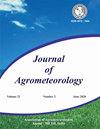Rice brown planthopper, Nilaparvata lugens (Stål) feeding behavior in relation to elevated CO2 and temperature
Q3 Agricultural and Biological Sciences
引用次数: 0
Abstract
Feeding behavior of brown planthopper, Nilaparvata lugens (Stål) populations collected from different geographical regions Ludhiana, Nalgonda and West Godavari at three generations 1, 5 and 10 fed on rice plants grown under different CO2 and temperature levels 1) Ambient CO2@ 380±25ppm + ambient temperature (aCO2+aT), 2) Elevated CO2@500±25ppm + ambient temperature (eCO2+aT) and 3) Elevated CO2@500±25ppm + elevated temperature (eCO2+eT) in closed CO2 chambers was studied. Elevated CO2 + elevated temperature increased feeding rate of BPH nymphs while BPH adults showed declined feeding rate. BPH nymphal feeding rate increased with progressive generations while it decreased in BPH adults. Ludhiana adult BPH population showed higher honeydew excretion compared to West Godavari and Nalgonda populations. CO2 + temperature levels at progressive generations have varying effects on adults and nymphs of three BPH populations. Biochemical composition of rice plants grown under different CO2 levels revealed increased rate of soluble sugars, phenols and decreased rate of reducing sugars, soluble proteins, free amino acids, nitrogen, potassium, phosphorous in elevated CO2 + elevated temperature levels compared to ambient conditions. Increased feeding rate of BPH under elevated CO2 levels may be to compensate changes in host plant quality i.e., high soluble sugars and low nitrogen.水稻褐飞虱 Nilaparvata lugens (Stål) 的取食行为与升高的二氧化碳和温度的关系
从不同地理区域 Ludhiana、Nalgonda 和 West Godavari 收集的三代褐飞虱 Nilaparvata lugens (Stål) 种群的取食行为 1、1)环境 CO2@380±25ppm + 环境温度(aCO2+aT);2)高浓度 CO2@500±25ppm + 环境温度(eCO2+aT);3)高浓度 CO2@500±25ppm + 高温度(eCO2+eT)。CO2 升高+温度升高提高了 BPH 若虫的摄食率,而 BPH 成虫的摄食率则有所下降。BPH 若虫的摄食率随着世代的增加而增加,而 BPH 成虫的摄食率则随着世代的增加而降低。与西戈达瓦里(West Godavari)和纳尔贡达(Nalgonda)种群相比,卢迪亚纳(Ludhiana)BPH 成虫的蜜露排泄量更高。渐进世代的二氧化碳和温度水平对三种 BPH 群体的成虫和若虫有不同的影响。在不同二氧化碳水平下生长的水稻植株的生化成分显示,与环境条件相比,在二氧化碳升高+温度升高的条件下,可溶性糖、酚的比率增加,还原糖、可溶性蛋白质、游离氨基酸、氮、钾、磷的比率降低。在二氧化碳浓度升高的条件下,BPH 的食量增加可能是为了补偿寄主植物质量的变化,即可溶性糖和氮的含量降低。
本文章由计算机程序翻译,如有差异,请以英文原文为准。
求助全文
约1分钟内获得全文
求助全文
来源期刊

Journal of Agrometeorology
农林科学-农艺学
CiteScore
1.40
自引率
0.00%
发文量
95
审稿时长
>12 weeks
期刊介绍:
The Journal of Agrometeorology (ISSN 0972-1665) , is a quarterly publication of Association of Agrometeorologists appearing in March, June, September and December. Since its beginning in 1999 till 2016, it was a half yearly publication appearing in June and December. In addition to regular issues, Association also brings out the special issues of the journal covering selected papers presented in seminar symposia organized by the Association.
 求助内容:
求助内容: 应助结果提醒方式:
应助结果提醒方式:


